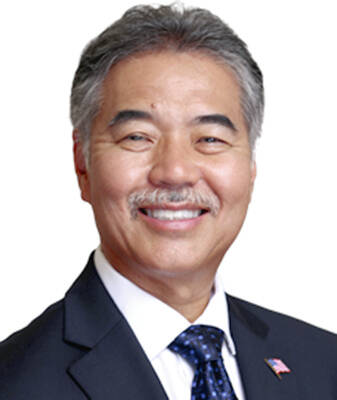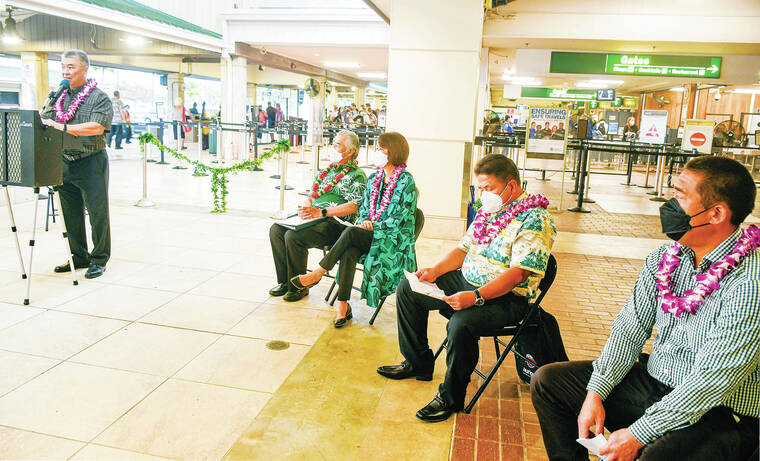LIHU‘E — The last time Gov. David Ige visited Kaua‘i, it was March 2021. He came for a blessing of the Hanalei Hillside as state and county agencies began work to clear the mud-and-rock-covered Kuhio Highway to allow access to and from Kaua‘i’s North Shore communities.
“This is the first trip to Kaua‘i in a nonemergency situation,” Ige said last week.
On this most recent trip, Ige and his team came for a blessing of the Lihu‘e Airport, showcasing the renovations to the lobby and ticketing area, marking yet another point of investment by the state in county infrastructure.
“The travel industry has changed due to the pandemic. We do think that the improvements to the airport would help in a lot of different ways,” Ige said.
The expansion, Ige said, not only was overdue, but is befitting in a time of social distancing.
“It improves access. It covers some of the areas that were not covered before, and creates more protected space for those coming and checking in,” he said. “It improves circulation. In the pandemic period, it’s a win-win.”
While visiting Kaua‘i, Ige took tours of the County Housing Agency’s Pua Loke and Kealaula affordable-housing complexes.
“Housing and fighting homelessness has been a priority for this administration,” Ige said. “Seeing how the mayor and the county have clustered those facilities together, it’s impressive to have it accessible. To have a transition facility to take homeless individuals and help, provide services. Then, to see the affordable-rental project in walking distance, I think is a model that makes a lot of sense.”
The project was partially funded with state ‘Ohana Zone money, which the state set aside for projects to house those without homes while they qualify for federal Section 8 rental assistance or find permanent housing, while providing a base for outreach services. For example, Kealaula, which opened in November 2020, was constructed using $2 million from state funds and $2.15 million in county money.
“It’s a partnership between the state and county, and it’s
remarkable how the mayor and county were able to get that project from design to construction and implementation so quickly,” Ige said. “It’s rewarding to see that happen.”
Kaua‘i is a model example for a few different initiatives and issues seen across the state.
Following the 2018 flooding, the state and county embarked on a Destination Management Action Plan.
“Kaua‘i was ahead of the curve, and that’s talking about changing the whole nature of the visitor industry and really being focused on regenerative tourism and being aware that it’s not just about getting more and more visitors; it’s about thinking about the quality of the visitors, and we’re making an effort to educate them about our unique culture here on the island,” Ige said. “The Native Hawaiian culture makes our community so special.”
Part of the DMAP planning included infrastructure improvements on the North Shore, including the Ha‘ena master plan, which created a reservation system for parking at Ha‘ena State Park.
“In addition to wanting to ensure that the visitors have respect for our environment and natural surroundings, (the plan) and focus is on improving the basic infrastructure in the high-priority areas, like we did here, in Ha‘ena and the North Shore of Kaua‘i,” Ige said. “Having that rain event in 2018, and washing out Ha‘ena State Park really encouraged the state to accelerate the implementation of the master plan at Ha‘ena.”
Ige pointed to the collaborative efforts between state, county and locals that made the plan implementable.
“Working with the community and working with the visitor industry, we did develop a plan to reduce the number of visitors that got there, to solve the parking problem that was so out of control,” Ige said.
“Working with the state and county to figure out what’s the best way working with a visitor industry to look at how they can reduce the impact by establishing shuttle services and moving parking lot of that area” was classic collaboration, he said.
”More importantly, working with cultural and nonprofit groups and organizations in the community to encourage them to share their knowledge about the culture, and Native Hawaiian experience, and really thinking about how we can make investments in the infrastructure in a way that both residents and visitors would benefit,” was another important takeaway, Ige said.
And by creating this system, a balance was struck for both locals and visitors.
“So I think Kaua‘i is the model of destination management,” Ige said. “I think that we’ve learned a lot together … to really identify the friction points and the priority areas for action and then really think about how do we implement a system that would allow us to manage numbers that are visiting high-impact areas and really make state investments to improve the parking access so that the number of visitors doesn’t overwhelm the enjoyment of the community.”
Learning efforts and growth have been key to overcoming the COVID-19 pandemic that has stretched for the last two years. Ige pointed to the state’s low infection rate and per-capita deaths as a significant sign of faring well through the pandemic. Only a few days ago, on Saturday, the state finally lifted its indoor-mask mandate.
“It really is because, as an island community, I think we all recognize that we have to make sacrifices, personal sacrifices, in order to keep the community healthy and safe,” he said. “That’s made a huge difference, and has helped Hawai‘i do better than any other state in terms of COVID response.”
•••
Sabrina Bodon, editor, can be reached at 245-0441 or sbodon@thegardenisland.com.






